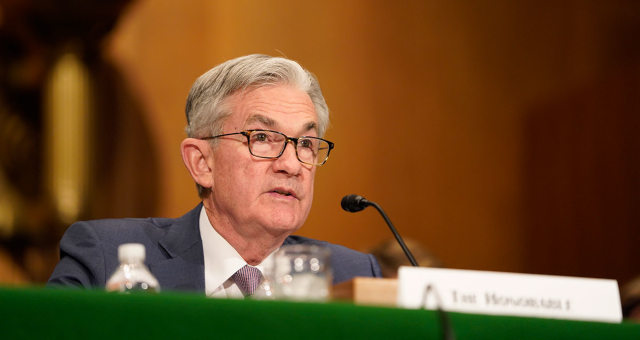Federal Reserve age contra congelamento do crédito e corta juro a zero

Os efeitos do coronavírus irão pesar sobre a atividade economia no curto prazo, aponta o Federal Reserve, liderado por Jerome Powell (Imagem: Flickr/Federal Reserve)
Em um movimento que lembrou os dias anteriores à explosão da crise de crédito vista em 2008, o 💥️Federal Reserve cortou o juro em 1 ponto percentual a um intervalo entre zero e 0,25% e anunciou medidas que devem levar ao mercado aproximadamente US$ 700 bilhões em liquidez.
Segundo o comunicado do Banco Central dos EUA (veja a íntegra abaixo), os efeitos do 💥️coronavírus irão pesar sobre a atividade economia no curto prazo e apresentar riscos para as projeções da economia.
“O comitê espera manter essa faixa até ter certeza de que a economia resistiu aos eventos recentes e está a caminho de alcançar suas metas máximas de emprego e estabilidade de preços”, explica o Fed.
As medidas de ampliamento da liquidez consistem na recompra de papéis do Tesouro no valor de US$ 500 bilhões e de outros US$ 200 bilhões em títulos lastreados em hipotecas.
As medidas de liquidez também foram tomadas pelo Banco do Canadá, Banco da Inglaterra, Banco do Japão, Banco Central Europeu e o Banco Nacional Suíço.
💥️Veja o comunicado (em inglês)
The coronavirus outbreak has harmed communities and disrupted economic activity in many countries, including the United States. Global financial conditions have also been significantly affected. Available economic data show that the U.S. economy came into this challenging period on a strong footing. Information received since the Federal Open Market Committee met in January indicates that the labor market remained strong through February and economic activity rose at a moderate rate. Job gains have been solid, on average, in recent months, and the unemployment rate has remained low. Although household spending rose at a moderate pace, business fixed investment and exports remained weak. More recently, the energy sector has come under stress. On a 12‑month basis, overall inflation and inflation for items other than food and energy are running below 2 percent. Market-based measures of inflation compensation have declined; survey-based measures of longer-term inflation expectations are little changed.
Consistent with its statutory mandate, the Committee seeks to foster maximum employment and price stability. The effects of the coronavirus will weigh on economic activity in the near term and pose risks to the economic outlook. In light of these developments, the Committee decided to lower the target range for the federal funds rate to 0 to 1/4 percent. The Committee expects to maintain this target range until it is confident that the economy has weathered recent events and is on track to achieve its maximum employment and price stability goals. This action will help support economic activity, strong labor market conditions, and inflation returning to the Committee’s symmetric 2 percent objective.
The Committee will continue to monitor the implications of incoming information for the economic outlook, including information related to public health, as well as global developments and muted inflation pressures, and will use its tools and act as appropriate to support the economy. In determining the timing and size of future adjustments to the stance of monetary policy, the Committee will assess realized and expected economic conditions relative to its maximum employment objective and its symmetric 2 percent inflation objective. This assessment will take into account a wide range of information, including measures of labor market conditions, indicators of inflation pressures and inflation expectations, and readings on financial and international developments.
The Federal Reserve is prepared to use its full range of tools to support the flow of credit to households and businesses and thereby promote its maximum employment and price stability goals. To support the smooth functioning of markets for Treasury securities and agency mortgage-backed securities that are central to the flow of credit to households and businesses, over coming months the Committee will increase its holdings of Treasury securities by at least $500 billion and its holdings of agency mortgage-backed securities by at least $200 billion. The Committee will also reinvest all principal payments from the Federal Reserve’s holdings of agency debt and agency mortgage-backed securities in agency mortgage-backed securities. In addition, the Open Market Desk has recently expanded its overnight and term repurchase agreement operations. The Committee will continue to closely monitor market conditions and is prepared to adjust its plans as appropriate.
Voting for the monetary policy action were Jerome H. Powell, Chair; John C. Williams, Vice Chair; Michelle W. Bowman; Lael Brainard; Richard H. Clarida; Patrick Harker; Robert S. Kaplan; Neel Kashkari; and Randal K. Quarles. Voting against this action was Loretta J. Mester, who was fully supportive of all of the actions taken to promote the smooth functioning of markets and the flow of credit to households and businesses but preferred to reduce the target range for the federal funds rate to 1/2 to 3/4 percent at this meeting.
In a related set of actions to support the credit needs of households and businesses, the Federal Reserve announced measures related to the discount window, intraday credit, bank capital and liquidity buffers, reserve requirements, and—in coordination with other central banks—the U.S. dollar liquidity swap line arrangements. More information can be found on the Federal Reserve Board’s website.
O que você está lendo é [Federal Reserve age contra congelamento do crédito e corta juro a zero].Se você quiser saber mais detalhes, leia outros artigos deste site.











Wonderful comments